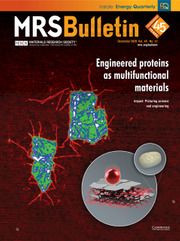Article contents
Functional Tissue Engineering Through Biofunctional Macromolecules and Surface Design
Published online by Cambridge University Press: 31 January 2011
Abstract
Tissue engineering is a rapidly developing discipline that has already entered the clinics and will tremendously change patient management in the near future. The aim of classical tissue engineering is to heal damaged or diseased tissues and organs through the combination of cells, biological factors, and porous biomaterials. The resulting, engineered tissue must possess appropriate functional properties to replace or supplement the targeted tissue. This is still a challenge to overcome before tissue-engineered products can be considered a complete success. Classical tissue engineering approaches rely on the use of mature cells expanded in vitro and transplanted alone or seeded in passive 3D scaffolds, which can lead to the loss of cellular phenotype and production of nonfunctional extracellular matrix. An emerging strategy involves the design of bioactive 3D scaffolds with instructive properties able to recruit cells in situ and direct tissue formation. Here, we present and discuss recent efforts to achieve smart scaffolds encompassing macromolecular biofunctionalization and surface design.
- Type
- Research Article
- Information
- MRS Bulletin , Volume 35 , Issue 8: Engineering Materials for Regenerative Medicine , August 2010 , pp. 584 - 590
- Copyright
- Copyright © Materials Research Society 2010
References
- 10
- Cited by


